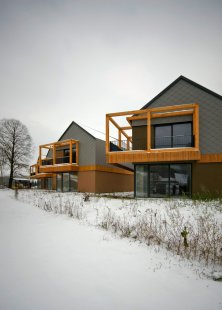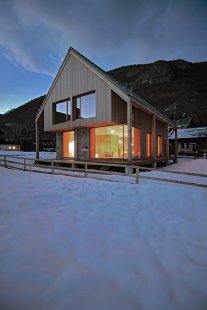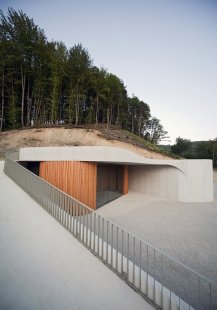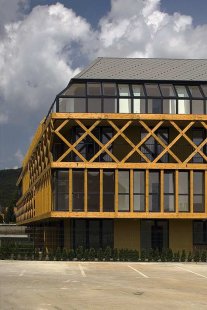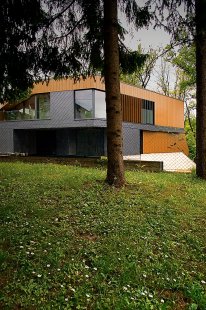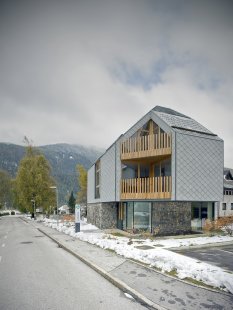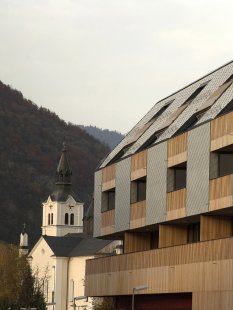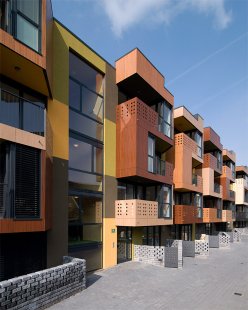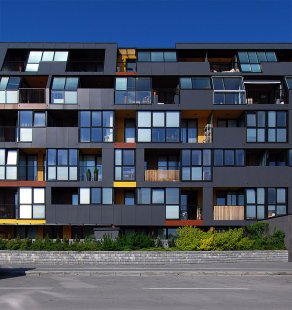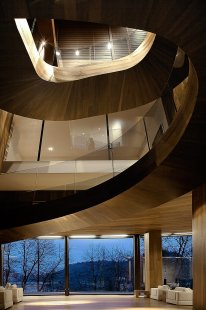
Interview with Špela Videčnik and Rok Oman from OFIS Architects
The interview with the founders of the studio OFIS Arhitekti – Špela Videčnik and Rok Oman took place on February 18, 2012, at Špela's invitation in the beautiful surroundings of the Triglav National Park in the village of Stará Fužina. The interview is part of the exhibition OFIS Architekti at Cabinet of Architecture in the Gallery of Fine Arts in Ostrava. The questions were posed by Rastislav Udžan.
EN: You come from a family with an architectural tradition. What attracted you to this profession?
RO: During the socialist period, it was one of the few professions that offered a certain degree of freedom and independence. Both my father and my uncle were architects. Architecture accompanied me from childhood, which is why my choice of profession was natural. I wanted to avoid a job where you have to clock in and out at the factory gate.
EN: You studied architecture in Ljubljana, a school inextricably linked with architect Jožo Plečnik. What kind of student were you?
RO: There is awareness of Plečnik in school, but also about Ivan Vurnik, which is still present. From the next generation, it was Plečnik's protégé Ravnikar, of whom I was a student. From today’s perspective, it was like taking a relay baton. The teaching was carried out in a fairly traditional spirit. Already in my second year, I met Špela. Although she was in a group focused on technical subjects, we understood each other creatively. We studied together, worked on semester projects, exams, and competitions. Thus, our future studio OFIS was formed. Our shared success came relatively quickly. In 1996, we won our first real project for three residential buildings. (Our conversation was briefly interrupted by a stunned gaze at the freely galloping horses in the scenery of the national park.) We established our studio in the euphoria of societal changes in the new state. It was remarkable to compete in a competition against the works of our professors, who also participated. Soon after came another success: winning the competition for the extension of the city museum in Ljubljana and the football stadium in Maribor. At those moments, it seemed that architecture was an easy profession.
EN: Do you think your successes are related to the generation of the 70s, which was significantly established in the architectural environment of Eastern Europe?
RO: Of course, we were the first generation to get real projects in young Slovenia. It was a period that is hardly going to be repeated. Construction companies even set up their own architecture departments. It was the era of the golden generation.
EN: How do you see the current position of an architect?
RO: (sigh) Nowadays, especially in times of global economic uncertainty, it is very challenging for young architects to succeed. It is hard to obtain any contract. We had a much more advantageous position than the generation after us.
EN: After a successfully launched career, however, you returned to school again. This time for postgraduate studies at the Architectural Association (AA) in London. What led you to that?
RO: After obtaining the contract for the city museum in Ljubljana, we more or less still didn’t know how the whole project would proceed. It was the same with the stadium in Maribor. We took the small time window we had. However, it was mainly Špela's decision that we would go to London. And it was the right decision. If we hadn't gone at that time, we would hardly have returned to school later. We also considered America, but we received a full scholarship for the school in London. It is a very interesting city in all aspects, including its cultural background. We made the most of our nearly two-year stay. Unlike our classmates, we spent more time in the city, in its theaters, galleries, and ongoing cultural events. We were rebellious students.
EN: Your portfolio is enriched by projects of scenographic architecture and video projections.
RO: In our beginnings, I became enthusiastic about this form of expression. It enriched me. It was an escape from the everyday demands for precision that architecture requires. Unfortunately, this phase has ended. Slovenia is a small country, and the market for scenographic architecture is filled with other groups. OFIS is an introverted studio. We are not very communicative in the domestic scene.
EN: How do you divide roles in the studio?
RO: OFIS is an open community. A stable team of four employees is supplemented by interns, mostly students. We offer them the opportunity to gain work experience in a real architectural environment. Over the years, many people have cycled through the studio. We maintain lively contact with some, just like in the case of our exhibition project with you and the Gallery of Visual Arts in Ostrava. The atmosphere in the studio has a cosmopolitan flavor, which inspires me. As for the projects, 70% of the contracts are precisely defined by the investor and do not allow for more significant interventions. The narrowly specified urban limits, firmly defined building volumes and program, set maximum heights and overhangs reduce the architect’s creativity and freedom to a minimum. We make use of the little that we can, mainly in the treatment of facade expression.
EN: Several other studios from your generation, such as Bevk Perovič, Sadar Vuga, Dekleva Gregorič, and others, have also gained prominence in the architectural consciousness. How did your joint project for the Noordung Vitanje Science Center come about?
RO: Yes, there are more of us. I am pleased that such a small country as Slovenia produces such distinctive architecture in an international context. The project was marked by a remarkable situation. The initial intention came from our acquaintance, who prepared a competition for selected studios. However, there was a lack of financing. I suspect it was Špela at one of our joint meetings who suggested that we take on the project together. We took that as a challenge. We reached a proposed concept together. Later, we divided the detailed and partial work. In such a scheme, albeit with a slight delay, we completed the project to the building permit. Currently, the project is being finalized.
EN: In the past, you actively skied.
RO: Yes, it was from 1979 to 1989. My father was also a skier. He participated in two Olympics. I got into this sport spontaneously. We were trained by Czech coach Zdeněk Remsa. A Czech coach Jaroslav Sakala still trains my former club. We had training in both countries, so the environment of Czechoslovakia is familiar to me.
Interview with Špela Videčnik.
EN: Since 1996, when you founded the OFIS studio with Rok, almost a hundred collaborators have passed through it. How did you arrive at the studio's working model?
SV: I started collaborating with Rok already during our studies. We went abroad a few times. That’s how the idea of setting up a studio based on exchange cooperation was born. The school in Ljubljana was based on classical principles. I liked it. It provided me with the foundations of the craft, but on the other hand, it was very closed to the world. That wasn’t enough for me. We competed a lot and participated in workshops. We had to be flexible. Our stay in London opened up further possibilities.
EN: From my perspective, the aesthetics of your projects arise from a narrow, investor-defined space of freedom.
SV: That can be said too. In the beginning, we worked on many social housing projects, which have tightly defined budgets. We tried to provide the pieces with some added value that would support the qualitative aspect of architecture, which would also support the investor's intent from a marketing perspective. It’s a matter of financial strategy. If you want to create a quality piece on a limited budget, you must find a viable balance between the aesthetic and functional value of the architecture. We looked for opportunities where we could save and where to invest money. At the same time, we remained flexible in dealing with the investor's ideas.
EN: In a relatively short period, you have created a number of works and gained international renown. Are you not planning to capitalize on this position and experience in academia?
SV: Initially, I hadn't thought about it. By coincidence, we were recently approached by Mohsen Mostafavi, the dean of Harvard University, with an offer to lead studios at the Faculty of Architecture under architect Scott Cohen. Starting from the summer semester, I will lead a seminar for first-year students, which I am looking forward to.
Thank you both for the interview and I wish you all the best.
RO: During the socialist period, it was one of the few professions that offered a certain degree of freedom and independence. Both my father and my uncle were architects. Architecture accompanied me from childhood, which is why my choice of profession was natural. I wanted to avoid a job where you have to clock in and out at the factory gate.
EN: You studied architecture in Ljubljana, a school inextricably linked with architect Jožo Plečnik. What kind of student were you?
RO: There is awareness of Plečnik in school, but also about Ivan Vurnik, which is still present. From the next generation, it was Plečnik's protégé Ravnikar, of whom I was a student. From today’s perspective, it was like taking a relay baton. The teaching was carried out in a fairly traditional spirit. Already in my second year, I met Špela. Although she was in a group focused on technical subjects, we understood each other creatively. We studied together, worked on semester projects, exams, and competitions. Thus, our future studio OFIS was formed. Our shared success came relatively quickly. In 1996, we won our first real project for three residential buildings. (Our conversation was briefly interrupted by a stunned gaze at the freely galloping horses in the scenery of the national park.) We established our studio in the euphoria of societal changes in the new state. It was remarkable to compete in a competition against the works of our professors, who also participated. Soon after came another success: winning the competition for the extension of the city museum in Ljubljana and the football stadium in Maribor. At those moments, it seemed that architecture was an easy profession.
EN: Do you think your successes are related to the generation of the 70s, which was significantly established in the architectural environment of Eastern Europe?
RO: Of course, we were the first generation to get real projects in young Slovenia. It was a period that is hardly going to be repeated. Construction companies even set up their own architecture departments. It was the era of the golden generation.
EN: How do you see the current position of an architect?
RO: (sigh) Nowadays, especially in times of global economic uncertainty, it is very challenging for young architects to succeed. It is hard to obtain any contract. We had a much more advantageous position than the generation after us.
EN: After a successfully launched career, however, you returned to school again. This time for postgraduate studies at the Architectural Association (AA) in London. What led you to that?
RO: After obtaining the contract for the city museum in Ljubljana, we more or less still didn’t know how the whole project would proceed. It was the same with the stadium in Maribor. We took the small time window we had. However, it was mainly Špela's decision that we would go to London. And it was the right decision. If we hadn't gone at that time, we would hardly have returned to school later. We also considered America, but we received a full scholarship for the school in London. It is a very interesting city in all aspects, including its cultural background. We made the most of our nearly two-year stay. Unlike our classmates, we spent more time in the city, in its theaters, galleries, and ongoing cultural events. We were rebellious students.
EN: Your portfolio is enriched by projects of scenographic architecture and video projections.
RO: In our beginnings, I became enthusiastic about this form of expression. It enriched me. It was an escape from the everyday demands for precision that architecture requires. Unfortunately, this phase has ended. Slovenia is a small country, and the market for scenographic architecture is filled with other groups. OFIS is an introverted studio. We are not very communicative in the domestic scene.
EN: How do you divide roles in the studio?
RO: OFIS is an open community. A stable team of four employees is supplemented by interns, mostly students. We offer them the opportunity to gain work experience in a real architectural environment. Over the years, many people have cycled through the studio. We maintain lively contact with some, just like in the case of our exhibition project with you and the Gallery of Visual Arts in Ostrava. The atmosphere in the studio has a cosmopolitan flavor, which inspires me. As for the projects, 70% of the contracts are precisely defined by the investor and do not allow for more significant interventions. The narrowly specified urban limits, firmly defined building volumes and program, set maximum heights and overhangs reduce the architect’s creativity and freedom to a minimum. We make use of the little that we can, mainly in the treatment of facade expression.
EN: Several other studios from your generation, such as Bevk Perovič, Sadar Vuga, Dekleva Gregorič, and others, have also gained prominence in the architectural consciousness. How did your joint project for the Noordung Vitanje Science Center come about?
RO: Yes, there are more of us. I am pleased that such a small country as Slovenia produces such distinctive architecture in an international context. The project was marked by a remarkable situation. The initial intention came from our acquaintance, who prepared a competition for selected studios. However, there was a lack of financing. I suspect it was Špela at one of our joint meetings who suggested that we take on the project together. We took that as a challenge. We reached a proposed concept together. Later, we divided the detailed and partial work. In such a scheme, albeit with a slight delay, we completed the project to the building permit. Currently, the project is being finalized.
EN: In the past, you actively skied.
RO: Yes, it was from 1979 to 1989. My father was also a skier. He participated in two Olympics. I got into this sport spontaneously. We were trained by Czech coach Zdeněk Remsa. A Czech coach Jaroslav Sakala still trains my former club. We had training in both countries, so the environment of Czechoslovakia is familiar to me.
Interview with Špela Videčnik.
EN: Since 1996, when you founded the OFIS studio with Rok, almost a hundred collaborators have passed through it. How did you arrive at the studio's working model?
SV: I started collaborating with Rok already during our studies. We went abroad a few times. That’s how the idea of setting up a studio based on exchange cooperation was born. The school in Ljubljana was based on classical principles. I liked it. It provided me with the foundations of the craft, but on the other hand, it was very closed to the world. That wasn’t enough for me. We competed a lot and participated in workshops. We had to be flexible. Our stay in London opened up further possibilities.
EN: From my perspective, the aesthetics of your projects arise from a narrow, investor-defined space of freedom.
SV: That can be said too. In the beginning, we worked on many social housing projects, which have tightly defined budgets. We tried to provide the pieces with some added value that would support the qualitative aspect of architecture, which would also support the investor's intent from a marketing perspective. It’s a matter of financial strategy. If you want to create a quality piece on a limited budget, you must find a viable balance between the aesthetic and functional value of the architecture. We looked for opportunities where we could save and where to invest money. At the same time, we remained flexible in dealing with the investor's ideas.
EN: In a relatively short period, you have created a number of works and gained international renown. Are you not planning to capitalize on this position and experience in academia?
SV: Initially, I hadn't thought about it. By coincidence, we were recently approached by Mohsen Mostafavi, the dean of Harvard University, with an offer to lead studios at the Faculty of Architecture under architect Scott Cohen. Starting from the summer semester, I will lead a seminar for first-year students, which I am looking forward to.
Thank you both for the interview and I wish you all the best.
The English translation is powered by AI tool. Switch to Czech to view the original text source.
